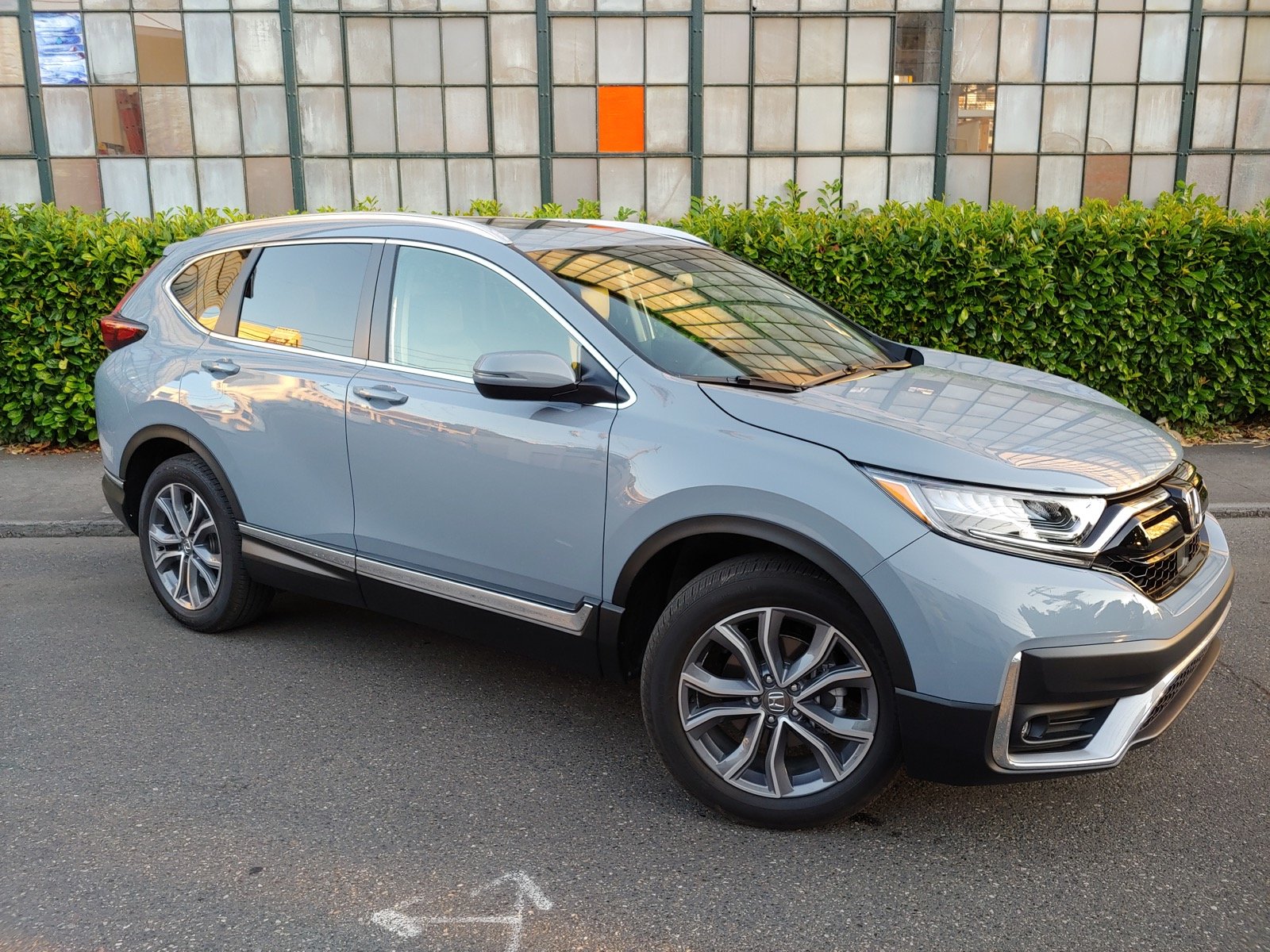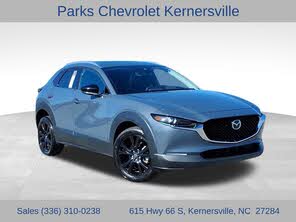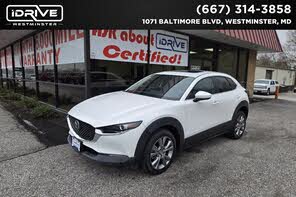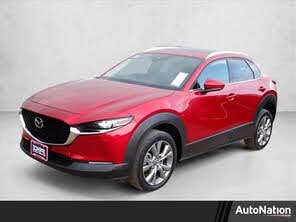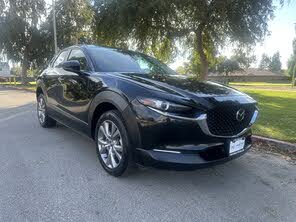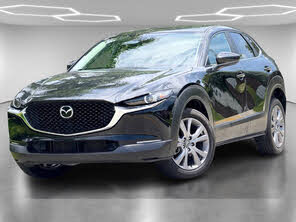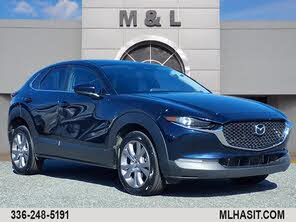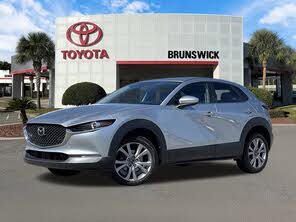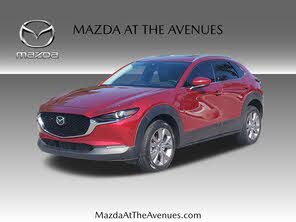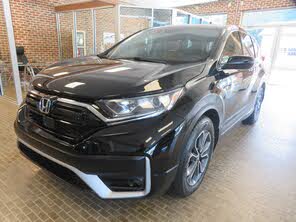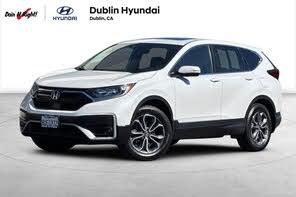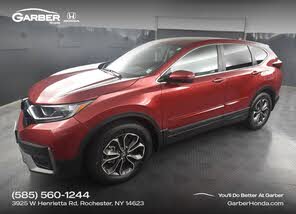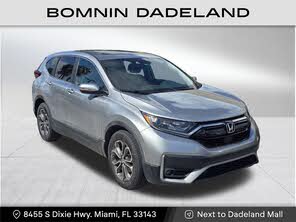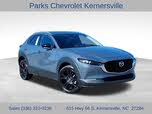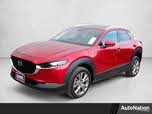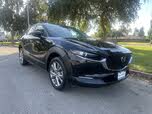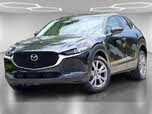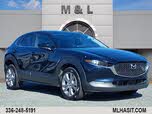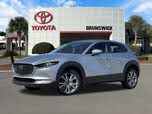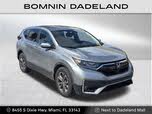2021 Mazda CX-30 vs 2020 Honda CR-V
Overview | |
MSRP$25,150 | MSRP$22,050 |
Listings1672 | Listings444 |
Ratings & Reviews | |
User Reviews | User Reviews |
Expert reviews7.5 out of 10 | Expert reviews7.5 out of 10 |
Pros
Cons
| Pros
Cons
|
2020 Honda CR-V Reviews SummaryHonda’s compact SUV has been satisfying buyers for more than two decades, with more than five million CR-V’s sold. Such a legacy means the CR-V has long had its wrinkles smoothed out into a comfortable and capable crossover package that’s only downside may be its sheer inoffensiveness. This year’s model gets engine and safety upgrades, which improve fuel economy and help to make Honda’s bestseller an even better value. | |
2021 Mazda CX-30 Reviews SummaryBlurring the lines between mainstream and luxury brands, the new 2021 Mazda CX-30 2.5 Turbo pairs effortless acceleration and engaging driving dynamics with a premium design and impressive technologies. Despite its substantial boost in power, this small crossover SUV isn’t about hardcore performance. Rather, it’s about delivering equal parts confidence, capability, style, and satisfaction, and at a price that stops where the traditional luxury brands are just getting started. | |
No video found | |
Popular Features & Specs | |
Engine1.5L 190 hp I4 | Engine2.5L 186 hp I4 |
Drive TrainFWD | Drive TrainFWD |
Seating Capacity5 | Seating Capacity5 |
Horsepower190 hp @ 5600 rpm | Horsepower186 hp @ 6000 rpm |
MPG City28 | MPG City25 |
MPG Highway34 | MPG Highway33 |
Engine | |
Engine Name1.5L 190 hp I4 | Engine Name2.5L 186 hp I4 |
Torque179 lb-ft @ 2000 rpm | Torque186 lb-ft @ 4000 rpm |
Horsepower190 hp @ 5600 rpm | Horsepower186 hp @ 6000 rpm |
DrivetrainFWD | DrivetrainFWD |
Fuel Economy | |
MPG City28 | MPG City25 |
MPG Highway34 | MPG Highway33 |
Interior | |
Seating Capacity5 | Seating Capacity5 |
Safety | |
Front Crash Overall5 | Front Crash Overall5 |
Side Crash Overall5 | Side Crash Overall5 |
Dimensions & Capacity | |
Cargo Space39.2 cu ft | Cargo Space20.2 cu ft |
Curb Weight3337 lbs | Curb Weight3234 lbs |
Height66.1 in | Height61.7 in |
Length182.1 in | Length173.0 in |
Width73.0 in | Width70.7 in |
Wheelbase104.8 in | Wheelbase104.4 in |
Maximum Payload1358 lbs | Maximum Payload983 lbs |
Number of doors4 | Number of doors4 |
Maximum Towing Capacity1500 lbs | Maximum Towing Capacity |
Overview | ||
MSRP | $25,150 | $22,050 |
Listings | ||
Ratings & Reviews | ||
User reviews | ||
Expert reviews | 7.5 out of 10Read full review | 7.5 out of 10Read full review |
Pros & cons | Pros
Cons
| Pros
Cons
|
Summary | Honda’s compact SUV has been satisfying buyers for more than two decades, with more than five million CR-V’s sold. Such a legacy means the CR-V has long had its wrinkles smoothed out into a comfortable and capable crossover package that’s only downside may be its sheer inoffensiveness. This year’s model gets engine and safety upgrades, which improve fuel economy and help to make Honda’s bestseller an even better value. | Blurring the lines between mainstream and luxury brands, the new 2021 Mazda CX-30 2.5 Turbo pairs effortless acceleration and engaging driving dynamics with a premium design and impressive technologies. Despite its substantial boost in power, this small crossover SUV isn’t about hardcore performance. Rather, it’s about delivering equal parts confidence, capability, style, and satisfaction, and at a price that stops where the traditional luxury brands are just getting started. |
Video | No video found | |
Popular Features & Specs | ||
Engine | 1.5L 190 hp I4 | 2.5L 186 hp I4 |
Drive Train | FWD | FWD |
Seating Capacity | 5 | 5 |
Horsepower | 190 hp @ 5600 rpm | 186 hp @ 6000 rpm |
MPG City | 28 | 25 |
MPG Highway | 34 | 33 |
Engine | ||
Engine Name | 1.5L 190 hp I4 | 2.5L 186 hp I4 |
Torque | 179 lb-ft @ 2000 rpm | 186 lb-ft @ 4000 rpm |
Horsepower | 190 hp @ 5600 rpm | 186 hp @ 6000 rpm |
Drivetrain | FWD | FWD |
Fuel Economy | ||
MPG City | 28 | 25 |
MPG Highway | 34 | 33 |
Interior | ||
Seating Capacity | 5 | 5 |
Safety | ||
Front Crash Overall | 5 | 5 |
Side Crash Overall | 5 | 5 |
Dimensions & Capacity | ||
Cargo Space | 39.2 cu ft | 20.2 cu ft |
Curb Weight | 3337 lbs | 3234 lbs |
Height | 66.1 in | 61.7 in |
Length | 182.1 in | 173.0 in |
Width | 73.0 in | 70.7 in |
Wheelbase | 104.8 in | 104.4 in |
Maximum Payload | 1358 lbs | 983 lbs |
Number of doors | 4 | 4 |
Maximum Towing Capacity | 1500 lbs | |
The 2020 Honda CR-V had been part of Honda’s fifth generation since its introduction in 2017, a design that had become both familiar and enjoyable to many. Its soft, curvy lines featured a family resemblance to Honda’s sedan lineup, exuding more of a station wagon vibe than an SUV. This painted the CR-V as an epitome of modern family transportation, boasting attractive exterior aesthetics.
However, stepping inside the CR-V told a different story. The interior design was a blend of various textures and materials, some upscale like wood-look trim and leather upholstery in higher trims, while others were less impressive, showcasing low-quality plastics. This contrast was a stark reminder that even the expensive versions were upscale versions of a basic car rather than truly premium products. The base model, the front-wheel-drive (FWD) LX, had an MSRP starting at $26,270, with four trim levels to choose from: LX, EX ($28,720), EX-L ($31,270), and Touring ($24,470). Each trim came with Honda’s standard three-year/36,000-mile warranty, with all-wheel drive (AWD) available as a $1,500 option across the lineup.
With a striking set of 17-inch alloy wheels as standard, the CR-V looked enticing, while trims like the CR-V EX boasted 18-inch wheels, and the Touring came with optional 19-inchers. Fabric seating was standard for the lower trims, with leather available in the higher trims. A retractable moonroof was standard for all but the LX, although it wasn't the panoramic-style sunroof offered by rivals like the Toyota RAV4 and Volkswagen Tiguan. Roof rails, albeit low-profile, were only available on the Touring model, aligning with the CR-V’s overall car-like aesthetic.
The 2021 Mazda CX-30 2.5 Turbo, on the other hand, struck a markedly different visual appeal. With exclusive shiny black 18-inch wheels, a shiny black grille, side mirror housings, and thick matte black body cladding, it had a more aggressive, stylized look. This aesthetics choice gave the CX-30 Turbo a light and agile appearance, appearing like the body was floating over its wheels.
The CX-30 was based on the Mazda3 hatchback, and though it shared some styling themes, it had a higher stance both visually and technically. This elevated ride height was noticeable as soon as you slid into the driver’s seat rather than dropping down. Inside, the cabin mirrored that of the Mazda3, flaunting quality materials, complementary tones, and textures for an upscale vibe. The Premium Plus trim even added chrome accents around the start button and a standard frameless rearview mirror. Buyers could choose between black and greige leatherette upholstery for standard trims and black or white leather for Premium trims.
Pricing for the CX-30 Turbo ranged from $31,000 to around $35,000, with our Snowflake White Pearl Mica test vehicle reaching $35,745 including the destination charge. This price bracket, combined with its unique styling and upscale interior, positioned the CX-30 as a viable premium alternative.

















For 2020, Honda streamlined the CR-V’s engine offerings, replacing the previous base 2.4-liter four-cylinder with a 1.5-liter turbocharged engine delivering 190 horsepower and 179 pound-feet of torque. This engine, coupled with a continuously variable automatic transmission (CVT), provided a balanced powertrain. Despite some typical CVT drawbacks like sluggish response and high-rev engine droning, Honda managed to mitigate these issues, making the CR-V feel quick, particularly in Sport drive mode. This was largely due to well-tuned transmission that mimicked a conventional automatic well enough to keep most drivers oblivious to the difference.
The CR-V’s car-like road manners were excellent, resembling the experience of driving a small sedan. Its steering had good weight, and the nimble handling was supported by a well-balanced chassis that was firm yet comfortable, with minimal body roll. Weighing in at just 3,337 pounds for the FWD LX model, the CR-V was among the lightest in its class, aiding its nimbleness and fuel economy. FWD models achieved an EPA rating of 30 miles per gallon combined, while AWD versions managed 29 mpg—putting it at the top of its class alongside the Subaru Forester and ahead of the Ford Escape and Toyota RAV4.
For those desiring even better fuel economy, Honda introduced a hybrid version of the CR-V, competing with hybrid variants of the RAV4 and Escape.
The 2021 Mazda CX-30, specifically the 2.5 Turbo model, featured a turbocharged 2.5-liter four-cylinder engine paired with a six-speed automatic transmission, standard i-Activ AWD, and refined front suspension tuning. This engine provided 227 horsepower on regular fuel and up to 250 horsepower on premium fuel, with torque measuring 310 pound-feet at 2,000 rpm or 320 lb-ft at 2,500 rpm. This resulted in impressive acceleration across various driving conditions.
Fuel economy for the CX-30 Turbo was rated at 25 mpg combined by the EPA, with real-world average coming in at 24.1 mpg. Given its 12.7-gallon fuel tank, this meant a relatively short maximum driving range of just over 305 miles, necessitating frequent fuel stops.
Mazda’s emphasis on driving dynamics was clear with the CX-30 Turbo. The vehicle offered effortless acceleration, though hints of torque steer were noticeable under hard acceleration. The refined G-Vectoring Control Plus (GVC-Plus) technology helped manage this, actively distributing up to half of the engine’s power to the rear wheels. The result was impressive traction and control, especially in off-road scenarios where the CX-30 Turbo’s extra ground clearance and Off-Road mode came into play.
Comparatively, the CX-30’s added height and weight made it slightly less enjoyable to drive than the Mazda3, even with improved suspension to account for the extra bulk. Nonetheless, it remained one of the most rewarding small SUVs, nearly rivaling luxury alternatives.
Honda’s expertise in vehicle packaging was evident in the CR-V. Its cabin was as roomy as the larger Volkswagen Tiguan’s, ensuring ample head- and legroom for both front and rear occupants. The well-designed seating position further enhanced comfort, providing excellent front visibility.
The CR-V’s cargo space was equally impressive, offering 75.8 cubic feet with the rear seats folded, rivaling the Tiguan despite being three inches shorter. The two-position load floor added to its practicality, allowing owners to maximize cargo space or create a flat floor as needed. The center console featured a deep well with a sliding cover, perfect for stowing items securely, while door pockets extended behind the lower door panels for additional storage.
In contrast, the Mazda CX-30 Turbo focused on driver comfort and interior quality. The eight-way power-adjustable driver’s seat offered superb long-distance support and ergonomic control positioning. Heated front seats and a heated steering wheel (on Premium and Premium Plus trims) enhanced comfort, although ventilated seats and greater passenger seat adjustability were noticeable omissions.
While the Mazda arranged controls around the driver, creating an intimate setting, the organic cabin shapes and minimalist design lent a sense of spaciousness. Rear seats, however, were cramped for adults, though padded seatbacks and rear air conditioning vents allowed for short-term comfort.
Cargo space in the CX-30 Turbo was more modest, providing 20.2 cubic feet behind the rear seats and 45.2 cubic feet with the seats folded, slightly less than the Mazda3 hatchback. Innovative storage solutions were less prevalent compared to the CR-V, with notable limitations like the positioning of the optional wireless smartphone charger.
The 2020 Honda CR-V’s infotainment system lagged behind its competition, especially in base LX trim with a lackluster 5-inch screen, offering minimal features beyond Bluetooth connectivity and Pandora compatibility. Even the 7-inch touchscreen on higher trims felt inadequate next to the optional 8-inch unit in the Tiguan or the full LCD instrument panel offered by VW. The Honda system, lacking physical buttons for easy operation, required multiple taps to navigate functions, making it cumbersome. Apple CarPlay and Android Auto, available only with the 7-inch screen, were not seamlessly integrated. Still, Honda provided multiple USB ports, with the Touring trim adding a wireless charger.
In contrast, the 2021 Mazda CX-30 Turbo featured an 8.8-inch infotainment-system display controlled via physical controls on the center console and steering wheel, or specific voice commands. Though not a touchscreen, the system provided clear, dual-pane information, with standard Apple CarPlay and Android Auto integration. Despite the non-touch interface, a natural voice recognition system aided in ease of use, although cycling through radio station favorites remained tedious.
Every CX-30 Turbo trim included Mazda Connected Services with remote engine start and vehicle finder, along with a trial period for 4G LTE WiFi hotspot service. Premium trims incorporated SiriusXM satellite radio, navigation, and a 12-speaker Bose premium audio system, which sounded exceptional due to strategic speaker placement during initial design phases. An Active Driving Display further enhanced the experience, projecting useful data onto the windshield, including blind-spot notifications.
The 2020 Honda CR-V came standard with the “Honda Sensing” system across all trims. This included forward-collision warning with automatic emergency braking, pedestrian detection, road-departure mitigation, and adaptive cruise control with lane-keeping assist. Standard features also included automatic high beams and a plethora of industry-standard safety equipment like stability control and airbags. The EX trims and above added blind-spot monitoring and cross-traffic monitoring. In crash testing, the CR-V earned five stars from the National Highway Traffic Safety Administration (NHTSA) and a Top Safety Pick from the Insurance Institute for Highway Safety (IIHS), although only the Touring trim’s LED headlights earned top scores.
The 2021 Mazda CX-30 Turbo also boasted high safety credentials with a Top Safety Pick+ rating from IIHS for 2020 and five stars in NHTSA tests, except for a four-star rollover rating. Every CX-30 Turbo came with a comprehensive suite of i-ActiveSense ADAS, including features like lane departure warning and adaptive cruise control. Premium trims added adaptive front lighting and advanced parking aids, while Premium Plus trims introduced a surround-view camera and Traffic Jam Assist for enhanced low-speed lane-centering. A mobile 9-1-1 system provided post-collision emergency notification, rounding out an impressive safety suite.
CarGurus highlights

According to CarGurus experts, the overall rating for the 2020 Honda CR-V is 7.5 out of 10, while the 2021 Mazda CX-30 scores 7.5 out of 10. Despite the identical ratings, factors such as performance and advanced technology might sway the decision towards the Mazda CX-30 for those looking for a more engaging driving experience and premium features. However, for practical, spacious, and family-friendly use, the Honda CR-V remains an excellent choice with its broader cargo space, efficient fuel consumption, and comprehensive safety features. In conclusion, while both vehicles are commendable, the final choice should align with the buyer's specific needs and preferences.
Choose the 2021 Mazda CX-30 if:
- You seek a stylish and sporty small SUV with an upscale interior feel.
- You desire robust performance with powerful turbocharged engine options.
- You appreciate advanced safety features combined with a premium audio and infotainment system.
Choose the 2020 Honda CR-V if:
- You need a spacious interior with ample cargo capacity and clever storage solutions.
- You prioritize a comfortable ride with excellent fuel economy for a compact SUV.
- You value standard safety features, including Honda Sensing, across all trim levels.
CarGurus highlights

According to CarGurus experts, the overall rating for the 2020 Honda CR-V is 7.5 out of 10, while the 2021 Mazda CX-30 scores 7.5 out of 10. Despite the identical ratings, factors such as performance and advanced technology might sway the decision towards the Mazda CX-30 for those looking for a more engaging driving experience and premium features. However, for practical, spacious, and family-friendly use, the Honda CR-V remains an excellent choice with its broader cargo space, efficient fuel consumption, and comprehensive safety features. In conclusion, while both vehicles are commendable, the final choice should align with the buyer's specific needs and preferences.
Choose the 2021 Mazda CX-30 if:
Shop Now- You seek a stylish and sporty small SUV with an upscale interior feel.
- You desire robust performance with powerful turbocharged engine options.
- You appreciate advanced safety features combined with a premium audio and infotainment system.
Choose the 2020 Honda CR-V if:
Shop Now- You need a spacious interior with ample cargo capacity and clever storage solutions.
- You prioritize a comfortable ride with excellent fuel economy for a compact SUV.
- You value standard safety features, including Honda Sensing, across all trim levels.

By: CarGurus + AI
At CarGurus, our team of experienced automotive writers remain at the heart of our content operation, conducting hands-on car tests and writing insightful guides that are backed by years of industry experience. To complement this, we are harnessing AI to make our content offering more diverse and more helpful to shoppers than ever. To achieve this, our AI systems are based exclusively on CarGurus content, ratings and data, so that what we produce is both unique to CarGurus, and uniquely helpful to car shoppers.
